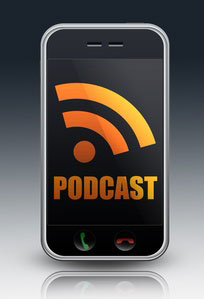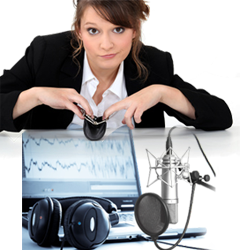 So what is Podcasting? Podcasting is online audio content that is delivered via an RSS feed. Podcasting is becoming a popular venue these days in the digital world. Have you ever wondered where Podcasting is heading? Here’s an article by Tech Crunch which discusses the Future of Podcasting. To read more, click here http://techcrunch.com/2015/07/18/the-future-of-podcasting/
So what is Podcasting? Podcasting is online audio content that is delivered via an RSS feed. Podcasting is becoming a popular venue these days in the digital world. Have you ever wondered where Podcasting is heading? Here’s an article by Tech Crunch which discusses the Future of Podcasting. To read more, click here http://techcrunch.com/2015/07/18/the-future-of-podcasting/
podcasting
How To Create and Publish Your Own Podcast
 You decided to start a podcast. You picked a great subject that you’re excited and knowledgeable about. You recorded your first episode, putting all that you’ve learned about home recording to good use. There’s a lot more to be done before you can call it a success, but it’s a relatively easy process. What follows assumes you have already recorded the audio for your show, which is ironically the easiest part of a podcast.
You decided to start a podcast. You picked a great subject that you’re excited and knowledgeable about. You recorded your first episode, putting all that you’ve learned about home recording to good use. There’s a lot more to be done before you can call it a success, but it’s a relatively easy process. What follows assumes you have already recorded the audio for your show, which is ironically the easiest part of a podcast.
Podcast subscriptions can be managed by many publishers, with iTunes probably being the biggest. Of course you can publish it yourself too, using a service like Google’s Feed Burner, or simply (shya!!) writing the RSS code yourself. The “long-hand” way (meaning “nobody actually does it like this anymore so don’t freak out reading this next part;)”) to publish is to create an XML file, which will be the source of your podcast information, like name, episode number and title, etc. This then becomes your RSS feed. Use your favorite text editor (Word, WordPad, Notepad, etc.) to create a document that will be saved in the .XML format. There is quite a bit of information available online about XML and RSS guidelines and standards if you want to do all of this manually. The elements (Title, Description, Link & Enclosure) of a podcast XML file are explained in more detail here: http://www.podcast411.com/howto_1.html.
But the “better mousetrap” is to use a program or service to take care of all that icky stuff for you. One excellent program – the one that I use for the Home Brew Audio Podcast – is called FeedForAll. The program makes it simple to input episode and podcast information, turning it into an optimized .XML RSS feed. Your podcast URL is the web address where your podcast episode has been uploaded. Remember that there are other types of podcasts than audio-only; supported file formats for podcasts published through iTunes are .m4a, .mp3, .mov, .mp4, .m4v, .pdf and .epub.
After your RSS feed is set up, technically it’s already published. Anyone can subscribe to it through a feed reader like, say, Google Reader, or any of a number of programs, sometimes called “podcatchers” or “feed aggregators” like FeedDemon, RSSOwl, etc. But in order to subscribe, people have to be able to find your podcast! For the widest exposure, you will want to submit your podcast to a larger publishing service, such as iTunes, for review. If your submission is rejected, look over the feedback to see what needs to be fixed. Check that your RSS feed is complete. For example, every <item> tag needs a matching </item> tag, just like in HTML or other coding language. Once your podcast is accepted by the publishing service, future episodes will be published by updating your XML file, which simply pushes the new information out via the RSS feed.
Not so bad, right? Every good product deserves a good audience, so spread the word about your new production. Share through social media and web forums pertaining to your subject. Be careful to follow local community guidelines. Sometimes a self-promoting post that doesn’t follow the rules of the forum can do more harm than good.
Many people produce podcasts as a labor of love or to drive traffic to their main website to help boost sales. But iTunes has a revenue-sharing system similar to that of YouTube, in that when users subscribe to your podcast, you’ll get a tiny fraction of the ad revenue. It may not be your ticket to a Lamborghini, but a few extra dollars here and there won’t hurt.
Tips For Recording Your Podcast
Publishing a podcast is an excellent and fun way to basically syndicate your own radio show. But a good podcast starts with good quality audio recording, which is actually pretty rare – something that baffles me, since it is easier and cheaper than ever before to record professional quality audio right from a cheap home studio. Just check out any of the hundreds of articles on our site for how to do that here.
But there are some more specific things you can do for podcast recording that apply no matter what gear you use. Check out the article below for these tips:
http://www.podcasting-tools.com/audio-recording-tips.htm
Home Recording If You're Not Rich
 Home recording can be pro recording. Oh yes. Let’s say you realized you absolutely needed to start creating your own audio and need a home recording studio. Maybe you need narration for a video you’re making. Maybe you have to start podcasting or creating e-learning programs; or my favorite…maybe you’re a musician who really wants to make a CD or maybe just some demo recordings. Whatever the reason, many folks think they only have a few choices; hire a voice actor to record any narration you may need, go to a recording studio and narrate yourself, or buy expensive specialized equipment and learn to use it so you can set up and record from a home recording studio.
Home recording can be pro recording. Oh yes. Let’s say you realized you absolutely needed to start creating your own audio and need a home recording studio. Maybe you need narration for a video you’re making. Maybe you have to start podcasting or creating e-learning programs; or my favorite…maybe you’re a musician who really wants to make a CD or maybe just some demo recordings. Whatever the reason, many folks think they only have a few choices; hire a voice actor to record any narration you may need, go to a recording studio and narrate yourself, or buy expensive specialized equipment and learn to use it so you can set up and record from a home recording studio.
All of the options above are valid and effective. But they are not the only viable options, especially if you are short on time and/or money. Studio time is on average, about $40 per hour (on the low end!). If you ask your local music store guy what you’d need to start a home pc recording studio, he’s going to suggest starting with a budget of at least $500 just for the bare minimums. So what other choice do you have?
Honestly, I expect folks not to believe this because it sounds “too easy.” But the truth is that if you have a computer made in the last 10 years that has a sound card, and a microphone…even one of those plastic PC mics costing $5.00 or less, all you need is to download free audio software ( I recommend downloading a program called Audacity, which is open-source) and you’ll have yourself a home pc recording studio capable of multi-track recording and audio editing! I’d wager that a huge percentage of folks reading this can put the above collection together without spending one penny. Lots more will only have to shell out the $5.00 for the mic;).
Once you have the starter studio set-up, all you need is to learn audio recording. “Hah!” you may say. “I knew it couldn’t be that easy!” Oh but it is. I’ll show you right now.
First, you’ll need to plug your mic into your sound card’s pink input jack. This is usually located on the back of your computer next to the green jack where your speakers are probably plugged in. Then you just need to set up a couple of things in the software before you start. Open Audacity and go to Edit/Preferences to open the Audacity Preferences window. Put a tick in the box next to “Play other tracks while recording new one.” Then click “OK.” Next, go into the “Sounds and Devices” window from the Control Panel in Windows. The icon looks like a grey speaker. Go to the tab marked “Audio,” and in the section called “Sound recording,” click on the “volume” button. That will bring up the Windows Mixer.” Find the channel that says “Stereo Mix” or “Wav Out” (depends on what sound card you have), and put a tick in the “Mute” box on that channel. Just close the Windows Mixer and you’re ready to rock!
Now record yourself saying (or singing) something. First, press the button in audacity with the big red dot (the universal symbol for “record”) on it. An audio “track” will appear as if by magic. Start making sounds into the microphone. When you’re done, click the button in Audacity with the big yellow square (meaning “stop”). Go back to the start of the song by clicking on the button in Audacity with the double purple arrows pointing to the left. Now listen to what you just recorded. Done! Want to add another track to play simultaneously with your voice? Just click on the record button again and a second track will start recording underneath the first one. If you’re using the mic for that next track (as opposed to just putting some pre-recorded music or sound effects on it as background), you’ll want to make sure you unplug the speakers from their green jack on the sound card. Otherwise the mic will pick up what’s coming through the speakers as well as what you’re actually trying to put on track 2. In the latter case, you’ll probably want to plug some ear-buds or headphones (the kind used for mp3 players will work fine) into the green jack on the sound card so you can hear the first track while you record the second.
You just made a multi-track recording! It really is that easy. If you’d like a bit more of a detailed walk-through, just put your e-mail into the form at the top right of this page for some free starter video tutorials on recording audio with Audacity that explain these concepts so anyone can understand them. If you know you’re ready to get started now, check out our home recording tutorial courses here: https://www.homebrewaudio.com/tutorials/
Happy recording!